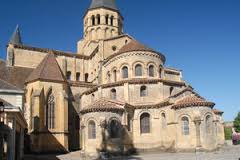A generation ago there was a great debate among medieval historians about what was termed a "feudal revolution" of the year 1000. It has more or less exhausted the debaters, but it still keeps popping up in discussions of the eleventh century, so I thought I should discuss it. (Note: medievalists these days all hate the word feudalism, with its plethora of contradictory meanings, but it keeps popping up anyway.)
This is what is called a "historiographic" debate, that is a discussion by historians of what happened and what does it mean, and why so-and-so's argument should have long been dismissed, and somebody-or-other's argument is full of novel insights. I'm not going to get into the historiography here (naming all the participants of the debate and summarizing their points), but I should note that this is why the discipline of History is a lot more than what happened in what order.
Basically the issue of the "feudal revolution" was the question of whether the changes of the early eleventh century represented a radical break with preceding years or whether there was gradual change. Although, as I have earlier discussed, nobody at the time thought the world was going to end in the year 1000, that year marks a handy break point between the Carolingian era (eighth through tenth centuries) and the high Middle Ages, the beginning of the Capetian era (Hugh Capet became king of France in 987, replacing the last Carolingian).
There is no question that a lot of changes took place in the years just before and after 1000 that seriously affected society. Especially the economy improved, a slightly warmer and drier climate making possible more reliable crops, and this increase in food production accompanied by the growth of towns, new trade routes, the clearing of forests and marshes for more agricultural land, and demographic growth.
This is also the time the first castles were built--there had long been fortresses, and there had long been palaces, but a castle combined elements of both, an elegant home for a lord that was also defensible. Knights also appeared for the first time, gaining visibility through the Peace of God councils that urged them not to attack the defenseless. The lords in their castles, surrounded by their knights, began assessing what were called "banal" dues, requirements that everyone in the region pay them some sort of fee, whether or not they were the lord's tenants.
How big a change was this? Supporters of a radical break have described the rise of castles and banal lordship as leading to new impositions on peasants, who were supposedly forced to toil even harder than ever for their pitiless overlords. The problem with this is that, although there are a lot of complaints in the eleventh century that "new and unheard of burdens" were being put on the poor (usually complaints from the poor themselves or their advocates in the monasteries), it had been common for hundreds of years to label anything bad as "new and unheard of."
Medieval people totally believed in tradition and the good old ways. They were doing new things all the time, but they always had to be explained as not really new or, better yet, returning to the good old ways the way they had been before recent efforts to mess them up. Thus anything bad was "new," whether it was really new or not.
The gradualist side of the "feudal revolution" debate has assembled a large number of examples of institutions and developments that were underway well before the year 1000. I myself am fairly firmly on the gradualist side, except for one aspect. The more determined "no-feudal-revolution"folks want to deny that knights were a new phenomenon around the year 1000.
I'm sorry, knights were new. You can't be a knight without a horse and affordable horseshoes, which they just didn't have before the late tenth century. Efforts to claim that Roman legions were just like knights or that any mention of a sword or shield must equate with knighthood are, shall we saw, unconvincing. Chivalry, the complex set of ideas of how knights should behave, was a late eleventh-century development, not something to be equated with ancient Roman stoicism.
But in one way I think the "revolutionaries" are right, and that is that things changed a lot for the peasants in the eleventh century. But not in the way they think. My own analysis of the documents suggests that the eleventh century was not a disaster for peasants but rather a time when the improving economy made life substantially better for the peasants, the ones after all who grew the food.
See how fun historiography can be?
© C. Dale Brittain 2021
For more on medieval life, see my new ebook, Positively Medieval: Life and Society in the Middle Ages. Also available in paperback.






